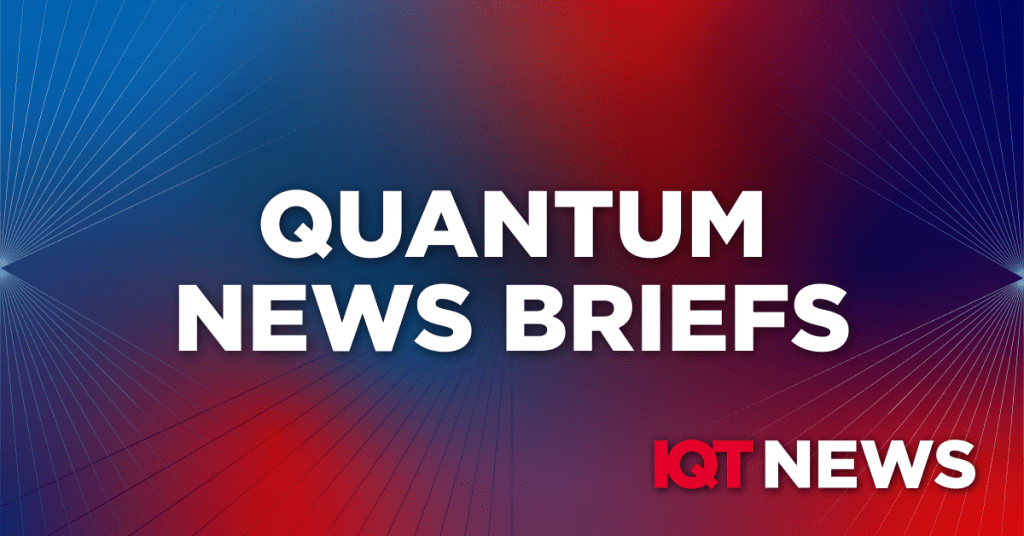News Briefs:
D-Wave announces Roadmap to extend Its Leap Quantum Cloud Service for AI and machine learning
The roadmap is intended to help customers address a variety of AI/ML workloads including pre-training optimization, more accurate and efficient model training, and opening new AI business use cases that require the integration of AI and business optimization, such as quantum supply chain optimization to support AI-predicted product demand requirements.
In response to growing demand from its customers, D-Wave’s Quantum AI development initiative comes at a time when the broader AI industry is confronting a computing crunch. The amount of compute and the associated energy costs needed to satisfy a growing set of use cases is rapidly escalating. D-Wave’s Quantum AI solutions aim to leverage annealing quantum computing’s unique capability in solving optimization problems to help customers discover better, faster and more energy efficient AI and ML workloads.
In Other News:
Fortune article cautions: “Wait for Q-day if you thought Crowdstrike debacle was bad”
Fortune’s Will Daniel warns in his August 2 article, “If you thought the Crowdstrike debacle was bad, wait for Q-day. That’s the term techies use to describe the day when quantum computing will break all modern encryption systems, and while it won’t arrive for years or even decades, CFOs should be mentally prepared.
Governments, businesses, and academics have been preparing for Q-day for a long time, developing quantum-resistant cybersecurity offerings. But as we saw with Crowdstrike’s botched update that led to billions in losses for companies worldwide, it’s not just cybersecurity hacks that can cause problems, but also updates and transitions to new cybersecurity systems.
That means migrating to new quantum-resistant cybersecurity systems is in itself a serious business risk.
Willconsulsted ne of the world’s top quantum computing researchers, Michele Mosca, a professor in the Department of Combinatorics & Optimization at the University of Waterloo, and the cofounder of the Institute for Quantum Computing.Mosca—who developed Mosca’s theorem, which describes when the world needs to become quantum-resistant—told Will that the risk of Q-day coming within the next five years is just 5%, but jumps to 30% over the next 10 years. And the professor had a message for executives who might brush off the cybersecurity threat from quantum computers, or resist transitioning to quantum-resistant security systems due to costs.
MIT News reports “Quantum computing research collaboration connects MIT with University of Copenhagen”
Researchers at MIT recently signed a four-year collaboration agreement with the Novo Nordisk Foundation Quantum Computing Programme (NQCP) at Niels Bohr Institute, University of Copenhagen (UCPH), focused on accelerating quantum computing hardware research according to MIT News July 31.
The agreement means that both universities will set up identical quantum laboratories at their respective campuses in Copenhagen and Cambridge, Massachusetts, facilitating seamless cooperation as well as shared knowledge and student exchange.
The team of William Oliver, the Henry Ellis Warren (1894) Professor within the MIT Department of Electrical Engineering and Computer Science (EECS), professor of physics, associate director of the Research Laboratory of Electronics, and the head of the Center for Quantum Engineering at MIT team will supervise the funded research, which will focus specifically on the development of fault-tolerant quantum computing hardware and quantum algorithms that solve life-science relevant chemical and biological problems. The agreement provides 18 million Danish kroner (approximately $2.55 million) from the Novo Nordisk Foundation Quantum Computing Program to support MIT’s part in the research.
Peter Krogstrup, CEO of NQCP and professor at Niels Bohr Institute, follows up, “We are excited to work with Will Oliver and his innovative team at MIT. It aligns very well with our strategic focus on identifying a path with potential to enable quantum computing for life sciences. The support aims to strengthen the already strong collaboration between Will and Morten’s team, a collaboration we hope to make an important part of the NQCP pathfinder phase over the coming years.
Wall Street Journal: ‘Quantum Drama’ book review: entangled in physics
In “Quantum Drama,” Jim Baggott and John Heilbron take readers on a fascinating journey according to Mario Livio in a book review in Wall Street Journal August 2, 2024.
Heilbron, who died last year, was a historian of science at UC Berkeley; Mr. Baggott is a chemical physicist and science writer. Their book leads us from the inception of quantum mechanics and the early disputes between Albert Einstein and Niels Bohr to the incredible insights emerging from entanglement, one of the most bizarre quantum phenomena in which two particles (such as electrons) become “entangled” and maintain a correlation no matter how far apart they are in space. Related: IQT’s Brian Siegelwax “Revisiting Bohr vs Einstein”.
Einstein mockingly referred to entanglement as “spooky action at a distance,” since the particles seemed to communicate faster than the speed of light. Together with the physicists Boris Podolsky and Nathan Rosen, the authors relate, he suggested that the two particles may have always had the particular properties later revealed experimentally, but that this information stayed hidden until actual measurements were carried out.
The authors explain, entangled particles do not communicate with each other faster than the speed of light—and thus entanglement does not contradict Einstein’s theory of special relativity. Today, scientists rather think of entangled particles as being one object, and entanglement is now at the heart of quantum technologies.
Mr. Baggott’s passion for the epoch-changing ideas inherent in quantum mechanics and Heilbron’s ardent devotion to the history of science shine on every page. Uninitiated readers may find some of the details challenging and perhaps even overwhelming. Yet those truly interested in the historical background, scientific underpinnings and philosophy of quantum mechanics, and who are willing to put in the necessary effort, will be amply rewarded.
